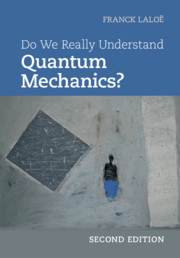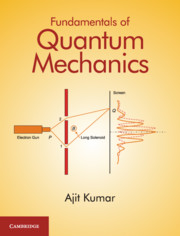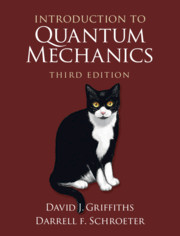Refine search
Actions for selected content:
3286 results in Quantum Physics, Quantum Information and Quantum Computation
Foreword
-
- Book:
- Do We Really Understand Quantum Mechanics?
- Published online:
- 01 February 2019
- Print publication:
- 14 February 2019, pp ix-x
-
- Chapter
- Export citation
Appendix G - Quantum Measurements at Different Times
-
- Book:
- Do We Really Understand Quantum Mechanics?
- Published online:
- 01 February 2019
- Print publication:
- 14 February 2019, pp 452-456
-
- Chapter
- Export citation
Appendix D - Maximal Probability for a State
-
- Book:
- Do We Really Understand Quantum Mechanics?
- Published online:
- 01 February 2019
- Print publication:
- 14 February 2019, pp 442-442
-
- Chapter
- Export citation
2 - Present Situation, Remaining Conceptual Difficulties
-
- Book:
- Do We Really Understand Quantum Mechanics?
- Published online:
- 01 February 2019
- Print publication:
- 14 February 2019, pp 21-48
-
- Chapter
- Export citation
Contents
-
- Book:
- Do We Really Understand Quantum Mechanics?
- Published online:
- 01 February 2019
- Print publication:
- 14 February 2019, pp v-viii
-
- Chapter
- Export citation
Appendix C - Attempting to Construct a “Separable” Quantum Theory
-
- Book:
- Do We Really Understand Quantum Mechanics?
- Published online:
- 01 February 2019
- Print publication:
- 14 February 2019, pp 439-441
-
- Chapter
- Export citation
Index
-
- Book:
- Do We Really Understand Quantum Mechanics?
- Published online:
- 01 February 2019
- Print publication:
- 14 February 2019, pp 527-530
-
- Chapter
- Export citation
Appendix E - The Influence of Pair Selection
-
- Book:
- Do We Really Understand Quantum Mechanics?
- Published online:
- 01 February 2019
- Print publication:
- 14 February 2019, pp 443-446
-
- Chapter
- Export citation
10 - Experiments: Quantum Reduction Seen in Real Time
-
- Book:
- Do We Really Understand Quantum Mechanics?
- Published online:
- 01 February 2019
- Print publication:
- 14 February 2019, pp 275-292
-
- Chapter
- Export citation
Preface
-
- Book:
- Do We Really Understand Quantum Mechanics?
- Published online:
- 01 February 2019
- Print publication:
- 14 February 2019, pp xi-xii
-
- Chapter
- Export citation

Do We Really Understand Quantum Mechanics?
-
- Published online:
- 01 February 2019
- Print publication:
- 14 February 2019

Fundamentals of Quantum Mechanics
-
- Published online:
- 20 October 2018
- Print publication:
- 19 March 2018

Introduction to Quantum Mechanics
-
- Published online:
- 12 September 2018
- Print publication:
- 16 August 2018
-
- Textbook
- Export citation
6 - Symmetries & Conservation Laws
- from Part I - Theory
-
- Book:
- Introduction to Quantum Mechanics
- Published online:
- 12 September 2018
- Print publication:
- 16 August 2018, pp 232-276
-
- Chapter
- Export citation
8 - The Variational Principle
- from Part II - Applications
-
- Book:
- Introduction to Quantum Mechanics
- Published online:
- 12 September 2018
- Print publication:
- 16 August 2018, pp 327-353
-
- Chapter
- Export citation
7 - Time-Independent Perturbation Theory
- from Part II - Applications
-
- Book:
- Introduction to Quantum Mechanics
- Published online:
- 12 September 2018
- Print publication:
- 16 August 2018, pp 279-326
-
- Chapter
- Export citation
3 - Formalism
- from Part I - Theory
-
- Book:
- Introduction to Quantum Mechanics
- Published online:
- 12 September 2018
- Print publication:
- 16 August 2018, pp 91-130
-
- Chapter
- Export citation
1 - The Wave Function
- from Part I - Theory
-
- Book:
- Introduction to Quantum Mechanics
- Published online:
- 12 September 2018
- Print publication:
- 16 August 2018, pp 3-24
-
- Chapter
- Export citation
Frontmatter
-
- Book:
- Introduction to Quantum Mechanics
- Published online:
- 12 September 2018
- Print publication:
- 16 August 2018, pp iii-iv
-
- Chapter
- Export citation
4 - Quantum Mechanics in Three Dimensions
- from Part I - Theory
-
- Book:
- Introduction to Quantum Mechanics
- Published online:
- 12 September 2018
- Print publication:
- 16 August 2018, pp 131-197
-
- Chapter
- Export citation
